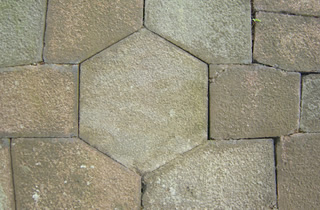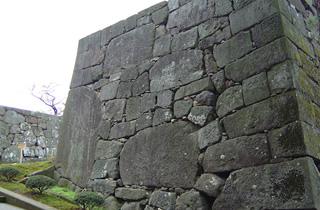Kanazawa Castle Park
Stone walls at Kanazawa Castle Park
Of all the castles in Japan, Kanazawa Castle has the biggest variety of stone walls. There are two reasons for this. First, stone walls at the castle were often rebuilt as building techniques advanced. In addition, stone wall engineers learned to build different kinds of walls, not only from such technical aspects as wall height, but also their position and direction, in line with the Chinese philosophical principles of positive and negative, and the five natural elements. We can learn these facts from the history of stone walls at the castle, and the literature describing secret techniques, for example" the Goto Family Document."
Most of the stones they used in the stone walls came from Mt. Tomuro, which is 8 kilometers to the southeast of Kanazawa Castle. There are two kinds of stones on this mountain Red Tomuro and Blue Tomuro. The combination of these two colors makes a unique, beautiful design. On Mt. Tomuro, we can see a part of the original stone quarry, and also old paths used for moving stones.
The first full-scale stone wall was built on the eastern side of Hon-maru in 1592. The original body of stone walls was finished in 1631, when the castle was completely reformed. Many stone walls were rebuilt from the mid-17th century to the early 19th century by reason of disaster.
There are two major buildings styles. One is Uchikomi-hagi, and the other is Kirikomi-hagi. In Uchikomi-hagi, stones are broken up, roughened a little on the surface, and then fitted together. In Kirikomi-hagi, stones are shaped and fitted together so neatly that there is not even enough room for one finger in the gaps between. It is tempting to think that these two styles were used at different times, as the building techniques developed, but in actual fact, from the mid-17th century, these two styles were used at the same time, at different places.

Kikko stone: A hexagonal stone was placed as a charm to protect the castle against fires. (Dobashi Bridge)

Kagami-zumi: Big stone pieces are placed horizontally and vertically. (Osaka-mon gate)